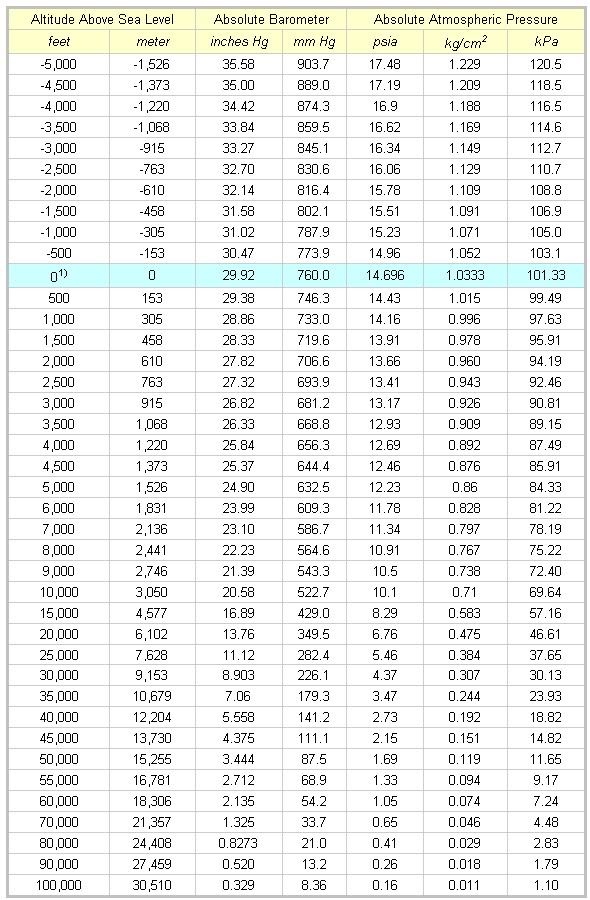However that same M8 at my shop on an average fall day made an actual 111.3 HP which when correct to SAE Standards was 140.8. So now consider the same unit with a Boondocker pump gas kit later that same day made 192 actual HP at 7.8 PSI.
While we are keeping it factual and civil.. I suspect this will quickly change but, maybe we can get lucky this time.
Let's push some numbers and theory
First a little theory..
Theory states that an engine should be able to double it's power with a doubling in atmospheric pressure.
So, let's assume that 1 ATM @ sea level is 14.7 so a 100HP engine at 1 ATM would produce 100HP. That same engine at 2 ATM (29.4psi (14.7 x 2) would produce 200HP (double the pressure). So, essentially at 14.7 PSI boost you should be able to double the power of any engine (in theory) . The reality is a bit different.. The real boost pressure to double the HP of an engine is closer to 16psi (this varies also between engines and turbos etc. etc.)
So, hypothetically speaking, if you dyno a STOCK engine at sea level and 1 atm and 60 degree air and get 100HP then you put that engine in 2 ATM of pressure, (adjust fuel etc. ect) that engine should and most likely will produce 200HP.
Now, take that same engine and equip it with a turbo set at 14.7 psi boost.. Will that engine produce 200HP? IMO, no... it will produce less.. why? That is a whole other discussion, but the simple answer is parasitic losses due to upset 2 stroke pipe effects, hotter air, and a few other factors. Hence some of the reasons why a turbo is preferred on 2 strokes vs. a Super Charger Set up.
OK, I think we can all agree that HP/psi-boost is NOT linear. meaning.. if you make 100HP on 10PSI boost, at 1 PSI boost you are not making 10HP (100/10). BUT from , say 10-11 psi you could be making 10HP gains.
I think we can also agree that different turbos and their associated designs and compressor maps get "happy" at different boost levels. So, the design of the turbo is a big player in determining where it fucntions the best. I think we can agree that nobody design a turbo system to be optimum at low boost levels like 1-5 psi..
So, we can assume that at the lower boost levels, the turbo is not producing the same kind of power increases that it is at the higher boost levels (when it is in its optimum area) So, from , say 8-14psi, the turbo is, most likely, running at it most optimum levels (of course this varies with turbos)
So, back to the theory.. double the atm pressure,double the power..
So, given the example above.. we have an engine that makes 111.3HP so theory would tell you that at 14.7 boost pressure that engine should produce 222.6HP but, factor in the losses and this would be closer to 16PSI boost to make the 222.6HP.. But let's call it 15 PSI just to have a whole number.
So, with example numbers.. 192HP@ 7.8PSI boost so 192-111.3 = 80.7HP on 7.8PSI boost or 73% more power.. So, this example shows that 73% of the power is made in the 1st 7.8 psi of boost pressure. considering, that the first 1-5 PSI the turbo is not operating in its "optimum" range... this is an outstanding accomplishment!
So now consider race gas kits with mild modifications pushing up-wards of 16 PSI capable of 300+ actual HP.
This is another quoted example.. So, the 140HP sled at 16PSI is now making 300+ HP If theory holds and is 100% accurate at 15PSI this same sled would make only 280HP (140 X 2). So, 1 PSI boost in this scenario is producing upwards of 20HP. Again, an outstanding accomplishment..
BUT.. if you can agree that there are losses associated with the turbo system (like I mentioned above) then these numbers are truely outstanding.
So, my question, since we are keeping it factual is:
1) How can the engine be producing more power than "Ideal" Laws of Physics can explain?
Keep in mind we are NOT dealing ,in reality, with ideal conditions..
Great discussion.. Let's try and keep it on topic and civil..
Kelsey




